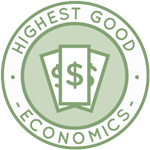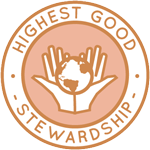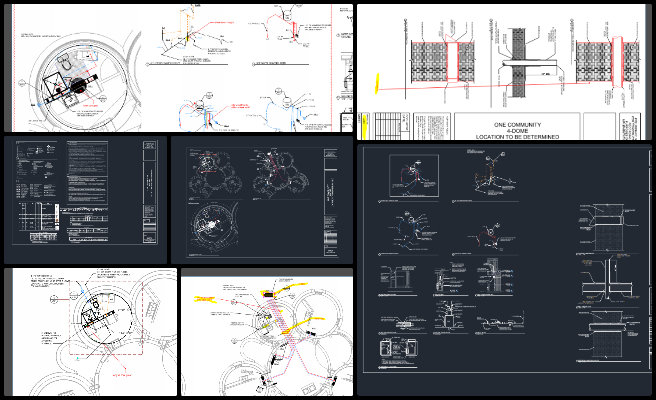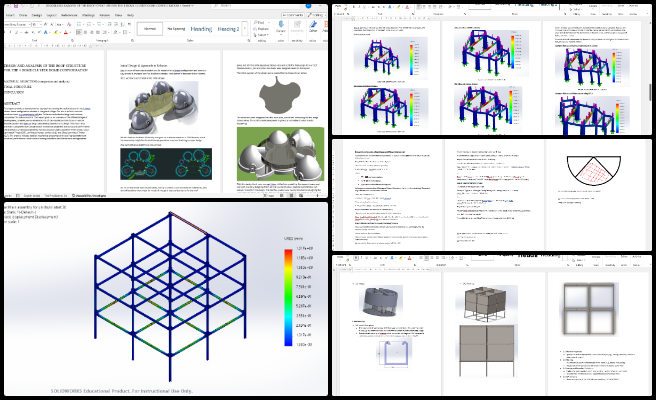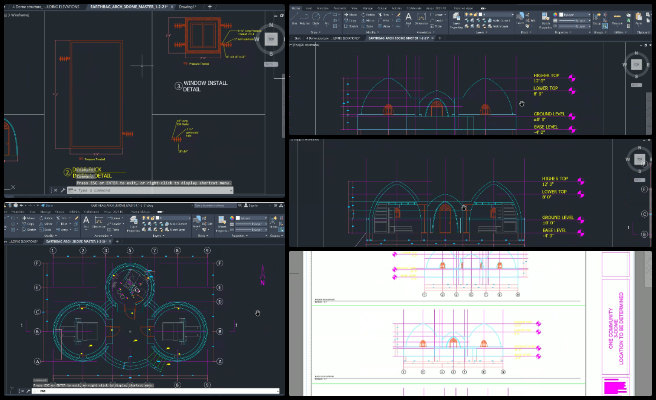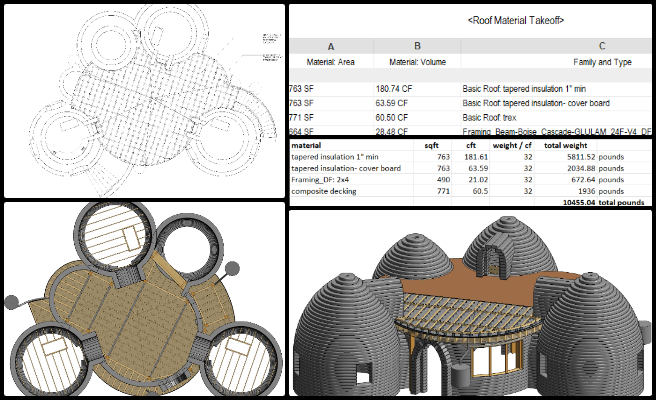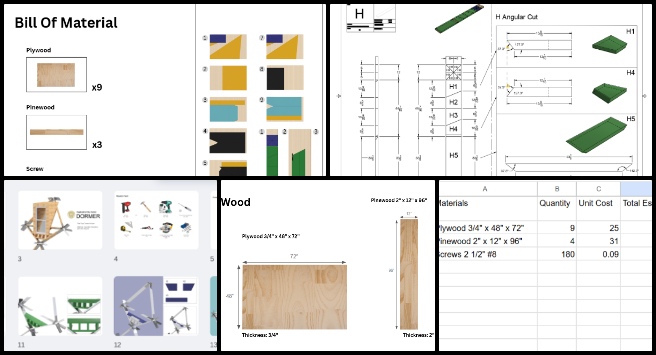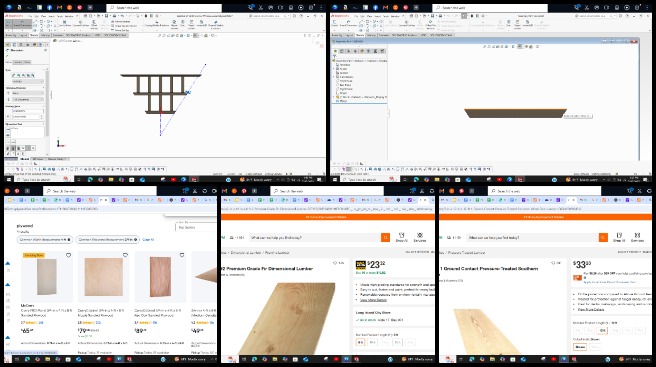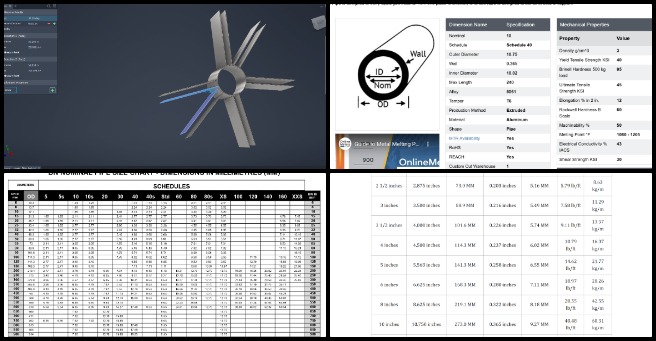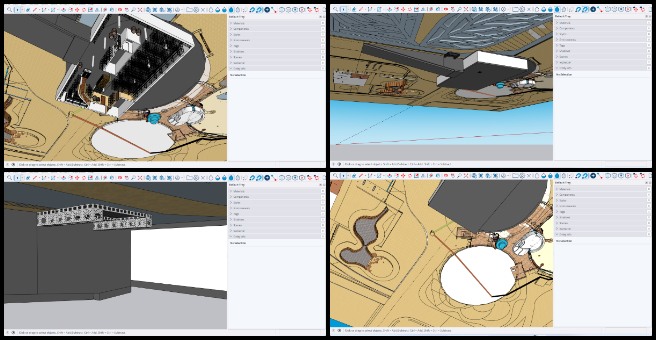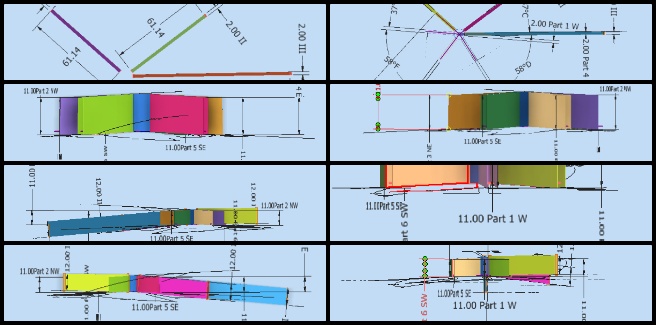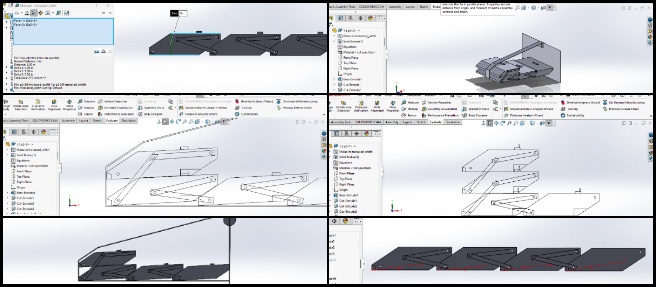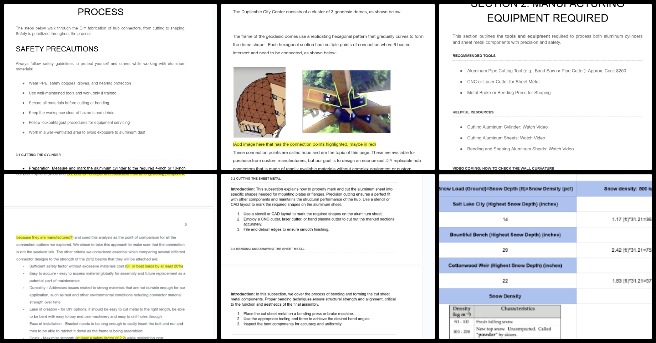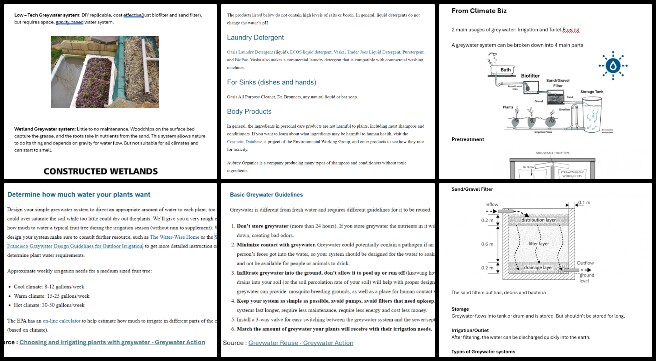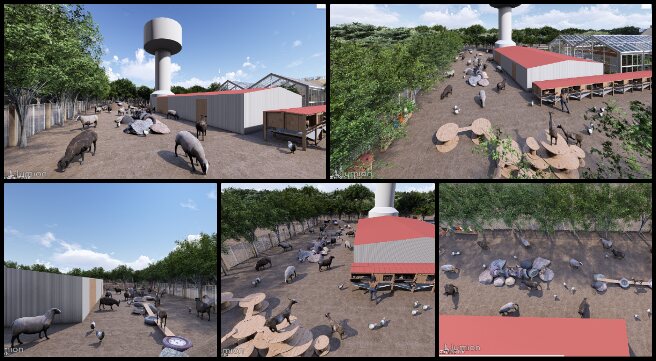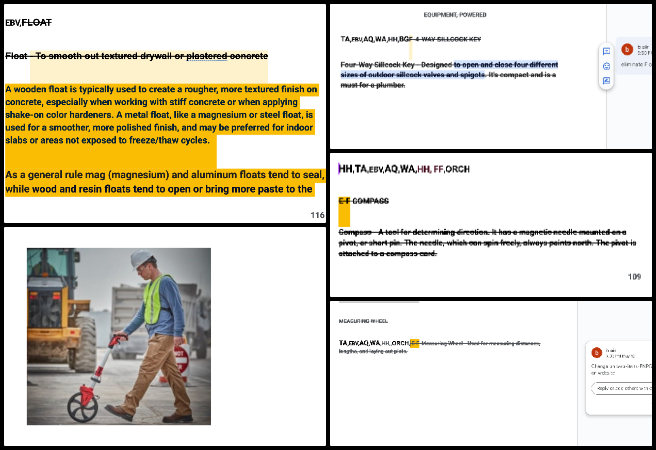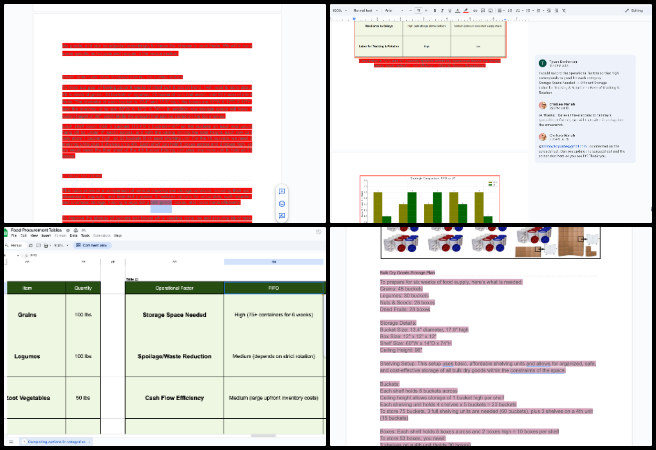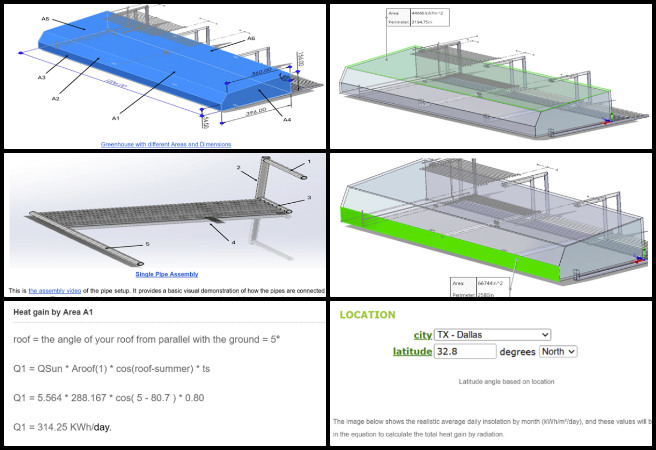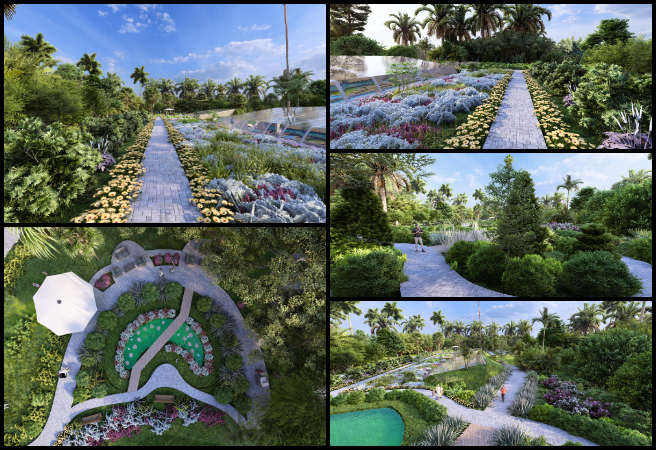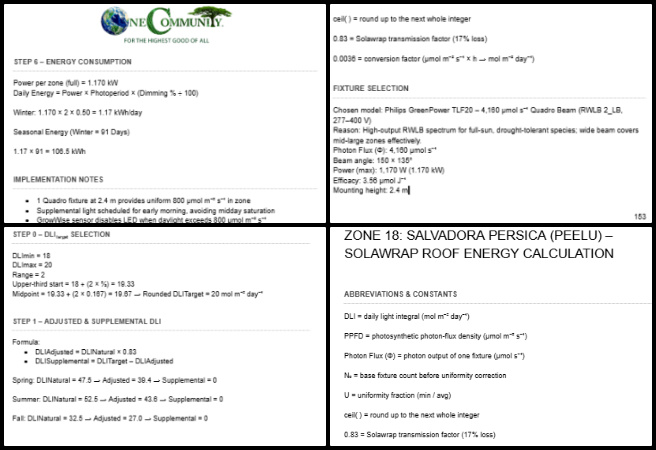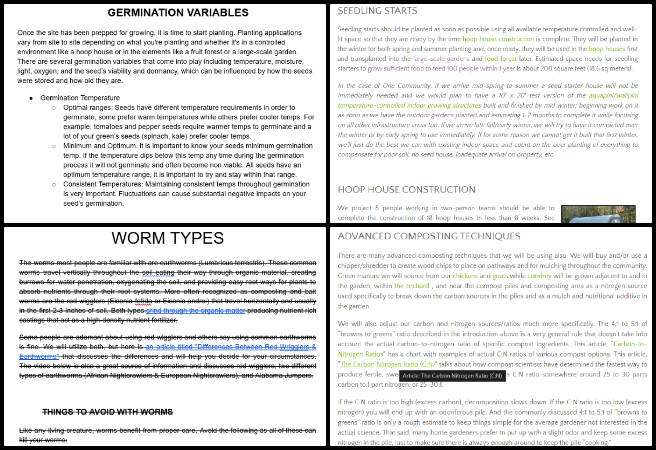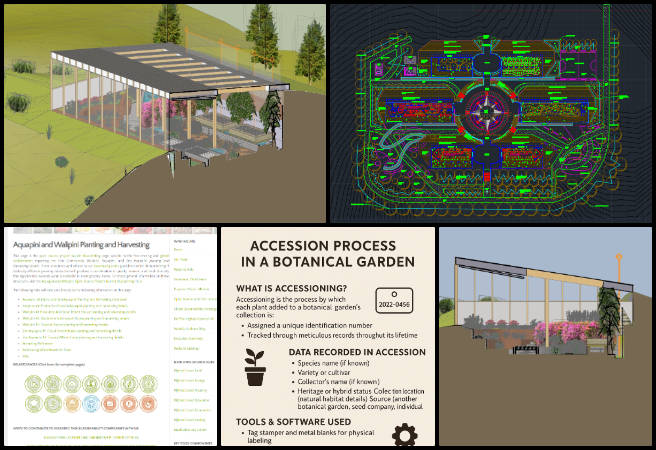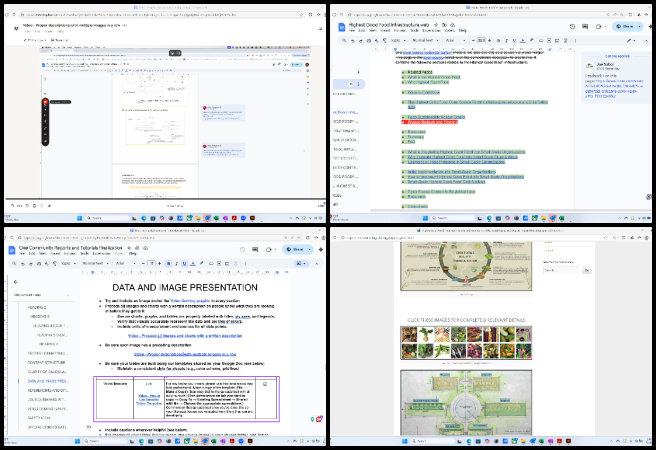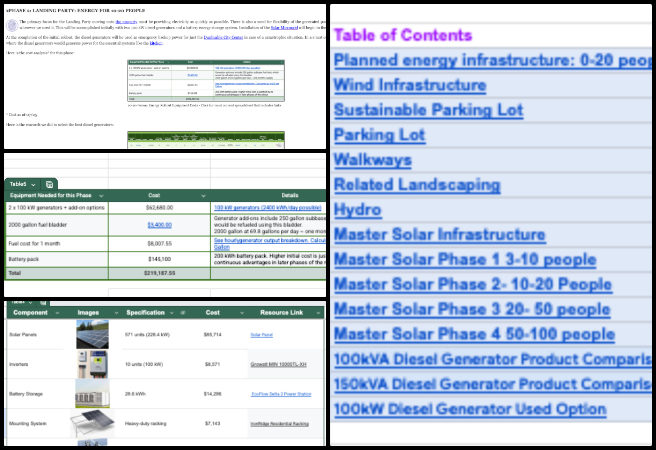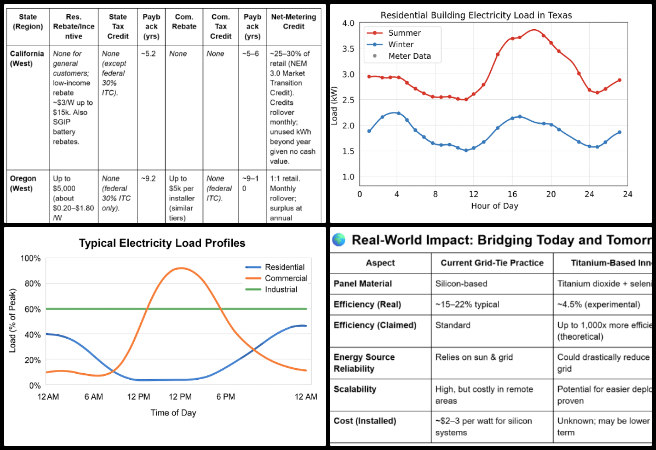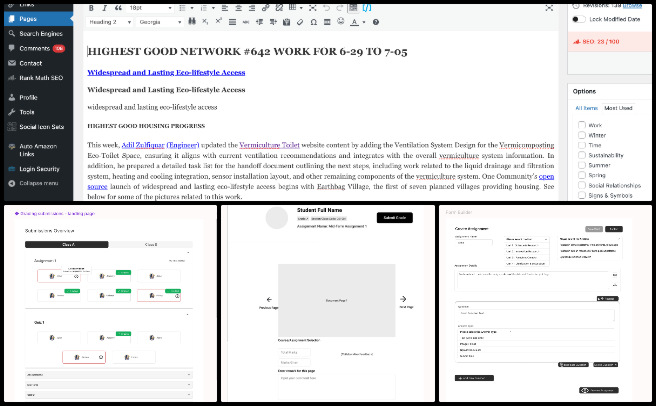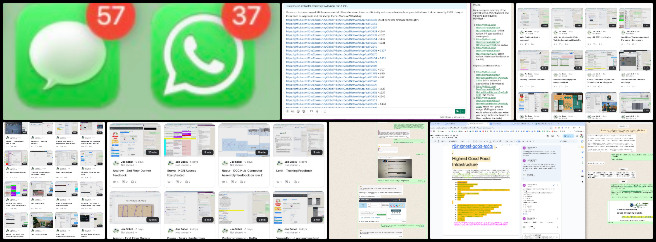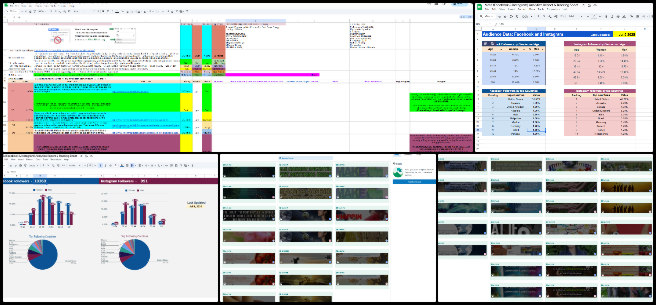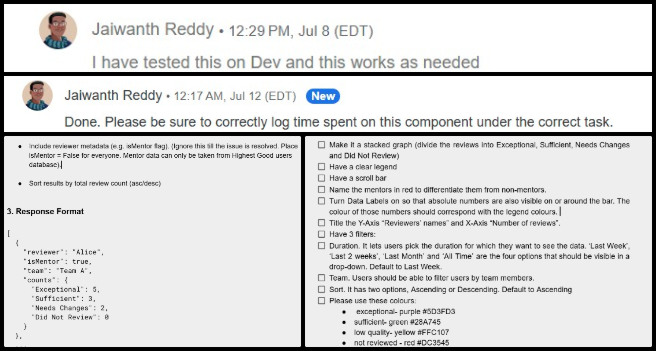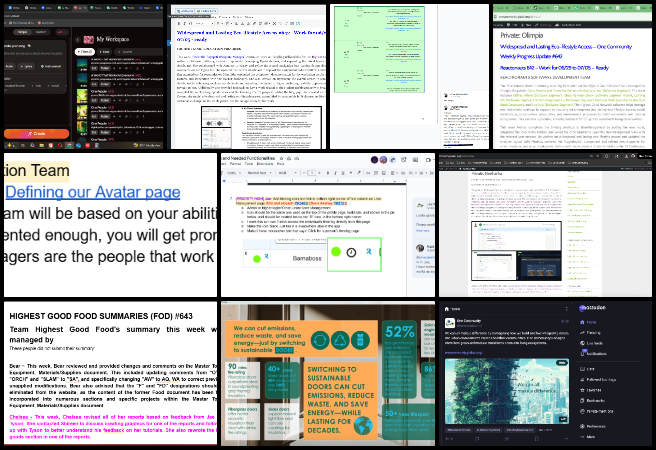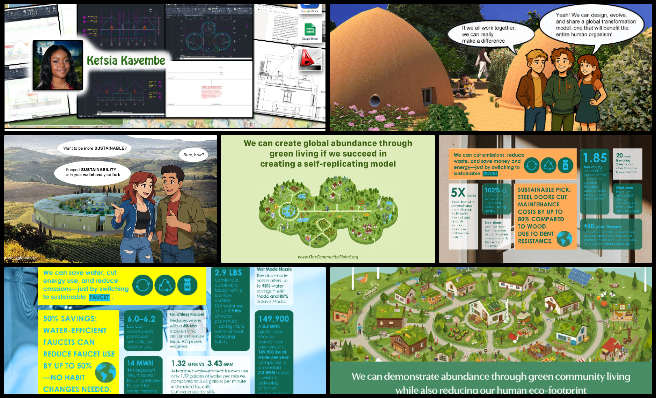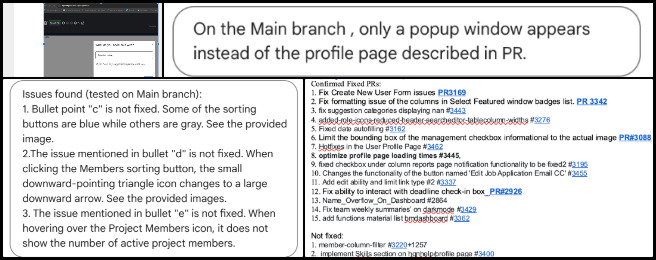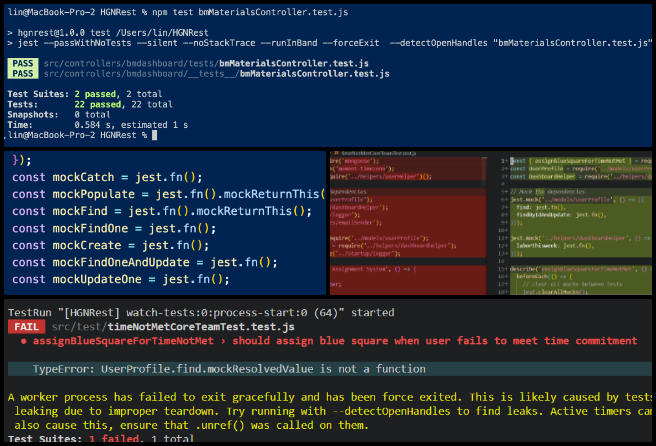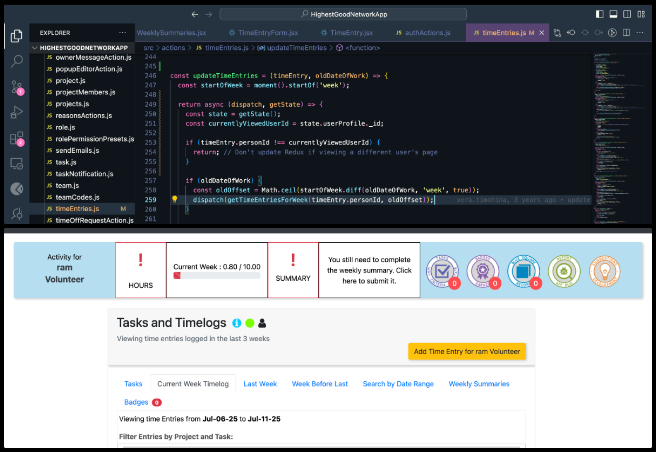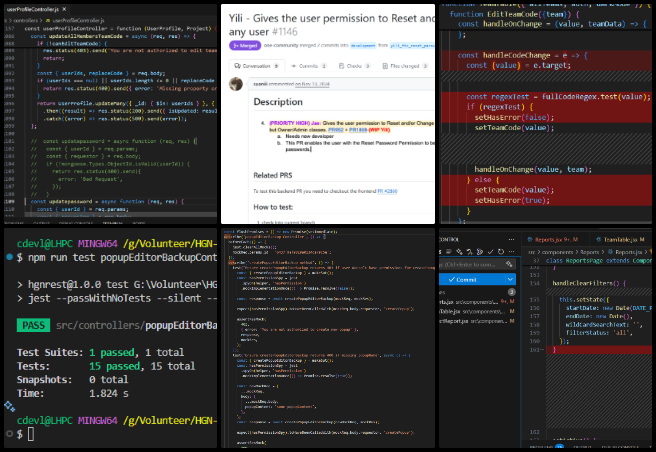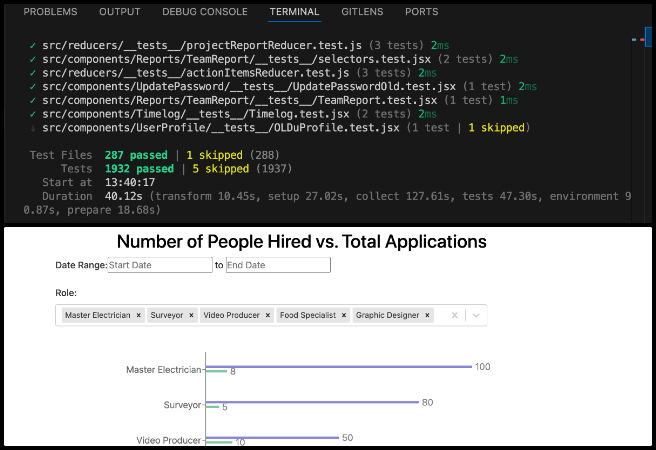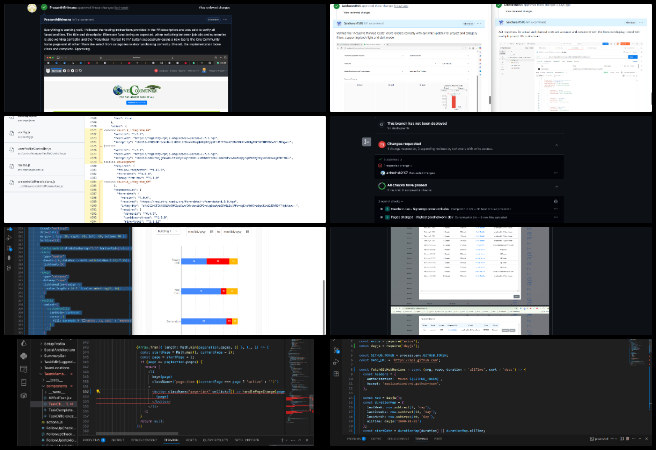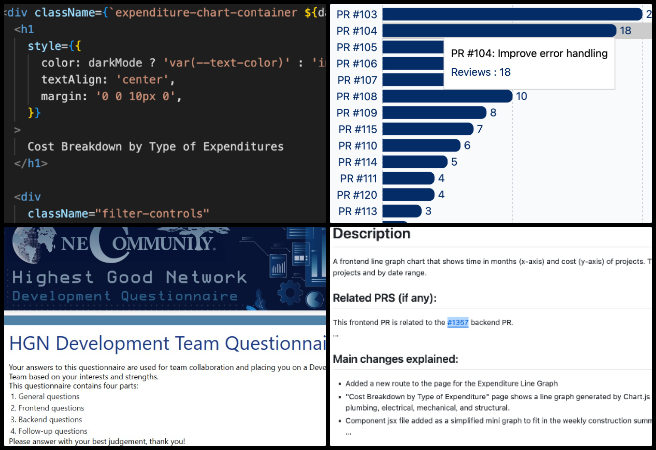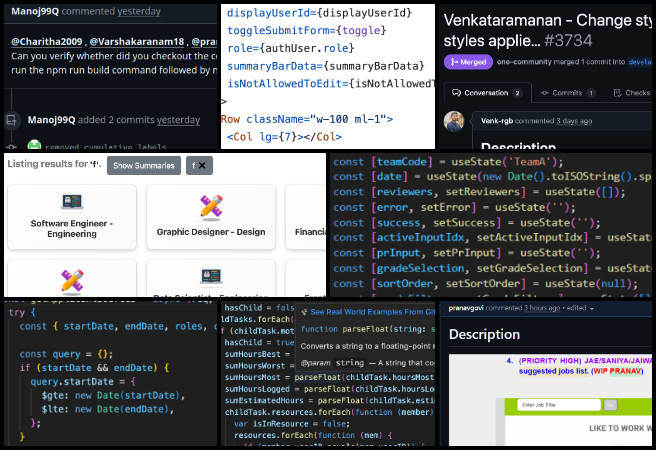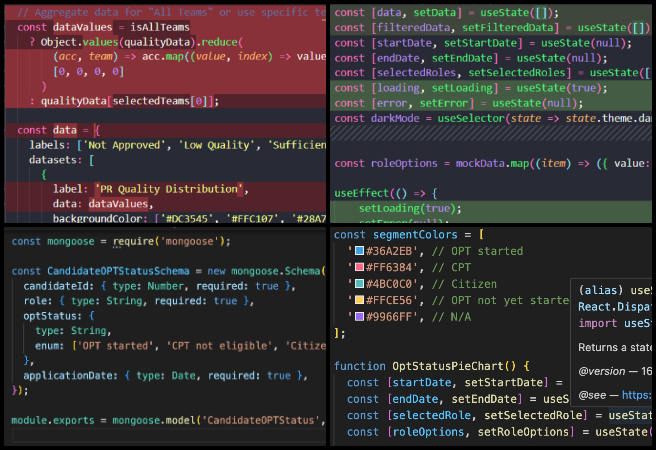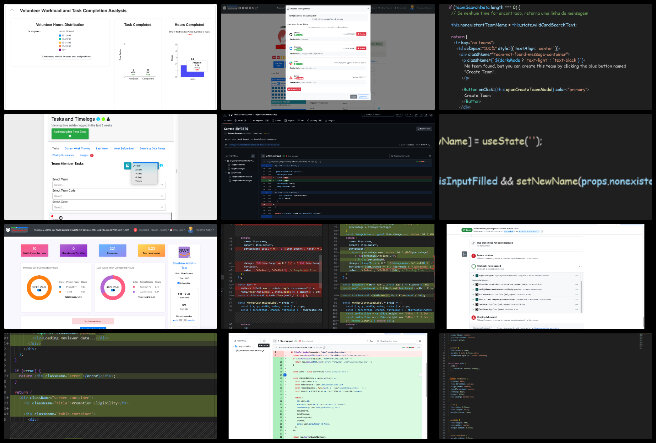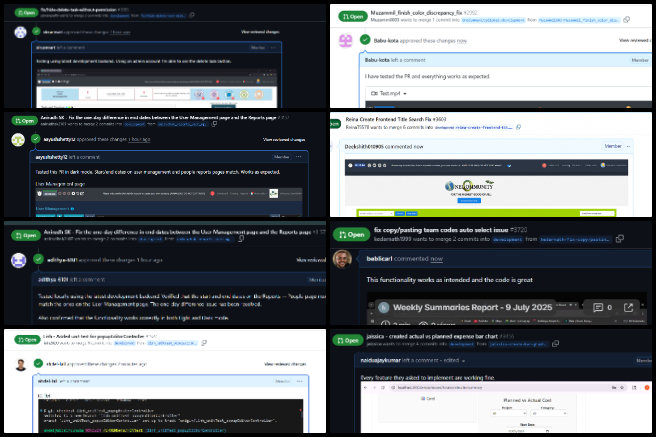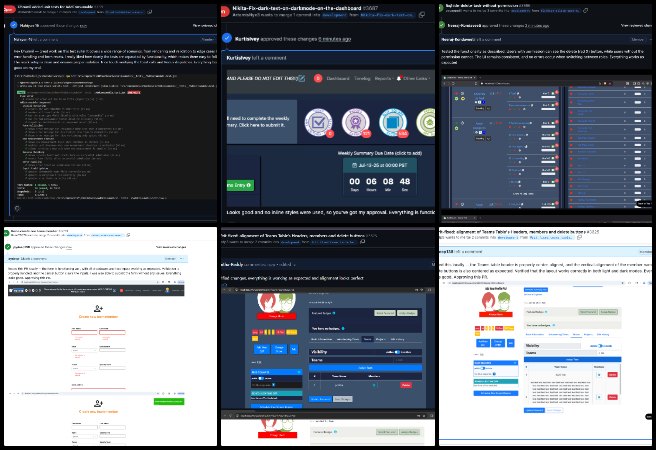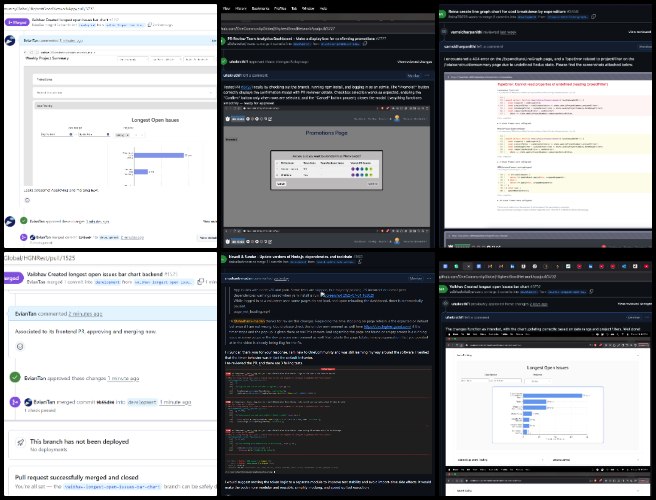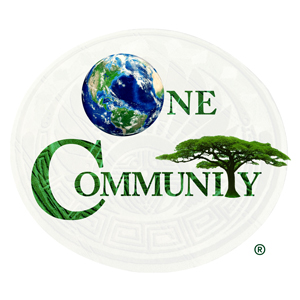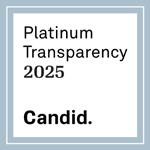Sustainable Future Building – One Community Weekly Progress Update #643
At One Community, we are advancing sustainable future building by creating and open sourcing comprehensive solutions for food, energy, housing, education, economics, social architecture, fulfilled living, global stewardship practices, and more. Developed by our all-volunteer team, everything we produce is free-shared to support a global network of teacher/demonstration hubs working together for The Highest Good of All. By evolving sustainability into something self-replicating and accessible to everyone, we’re helping regenerate our planet and create a world that works for all.
- Here’s our project overview
- Here’s our world-change methodology
- Here’s how this becomes self-replicating
- Here’s how we are open source and free-sharing all the do-it-yourself designs
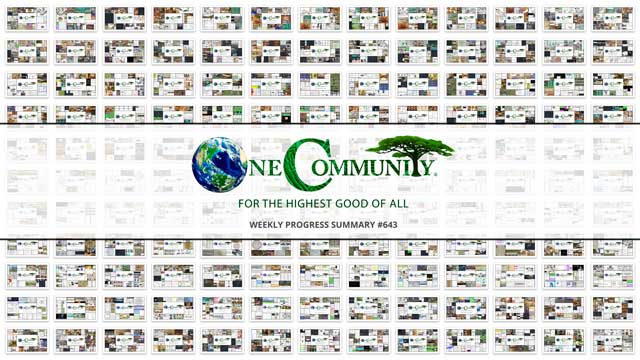
OUR MAIN OPEN SOURCE HUBS
Click on each icon to be taken to the corresponding Highest Good hub page.
One Community’s physical location will forward this movement as the first of many self-replicating teacher/demonstration communities, villages, and cities to be built around the world. This is the July 14th, 2025 edition (#643) of our weekly progress update detailing our team’s development and accomplishments:
Sustainable Future Building
One Community Progress Update #643
DONATE | COLLABORATE | HELP WITH LARGE-SCALE FUNDING
CLICK HERE IF YOU’D LIKE TO RECEIVE AN EMAIL EACH WEEK WHEN WE RELEASE A NEW UPDATE
YOU CAN ALSO JOIN US THROUGH SOCIAL MEDIA
ONE COMMUNITY WEEKLY UPDATE DETAILS
HIGHEST GOOD HOUSING PROGRESS
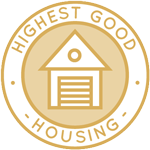 One Community is advancing sustainable future building through Highest Good housing that is artistic and beautiful, more affordable, more space efficient, lasts longer, DIY buildable, and constructed with healthy and sustainable materials:
One Community is advancing sustainable future building through Highest Good housing that is artistic and beautiful, more affordable, more space efficient, lasts longer, DIY buildable, and constructed with healthy and sustainable materials:
- Learn about: Our Upcoming Crowdfunding Campaign
- Learn about the different village models: 7 Sustainable Village Models
- Visit the open source portals for the first two: Earthbag Village OS Hub | Straw Bale Village OS Hub
This week, Derrell Brown (Plumbing Designer) continued working on the Earthbag Village 4-dome home plumbing and mechanical details. He coordinated with Michaela to address follow-up items related to finalizing the plumbing plans, including analyzing the plumbing isometrics and enlarged floor plans. Following the discussion, he updated the plans based on received comments, added a separate sheet to include isometric views with details, and corrected minor plotting errors. He then plotted a color set for the architect to review. One Community’s open source launching of sustainable future building begins with Earthbag Village, the first of seven planned villages providing housing. See below for some of the pictures related to this work.
Karthik Pillai (Mechanical Engineer) continued working on the ongoing report for the Earthbag Village 4-dome cluster roof design, with a focus on material details needed to improve the accuracy of the live load calculations. This week he worked on updating the project report and re-running structural analyses to include quantitative data. For the Vermiculture Toilet project, he modified the drawer design and continued work on the associated report. Karthik also focused on adjusting the waste dumping mechanism and is aiming to complete the modifications within the estimated project hours. As the first of seven planned villages, the Earthbag Village provides the initial housing within One Community’s open source designs for sustainable future building. See the work in the collage below.
Ketsia Kayembe (Civil Engineer) worked on the windows and doors details drawings for the three-dome structure of the Earthbag Village. She received feedback from Rumi and edited the files accordingly. Ketsia also began working on the excavation drawings by gathering the necessary information to edit the files in AutoCAD and bring them to a construction-ready level while following the standards. One Community’s open source framework of sustainable future building begins with Earthbag Village, the first of seven planned villages providing housing. See below for some of the pictures related to this work.
Michaela Silva (Architect) continued working on finalizing the interior of the Earthbag Village. She gathered the weights of the XPS tapered insulation, cover board, 2×4 framing, and composite decking in the roof assembly and calculated their areas and total weights. She also updated the pedestals and framing to a 16-inch by 16-inch on center grid to align with the maximum joist spacing allowed for composite decking. The Earthbag Village is the first of seven villages to be built as part of One Community’s open source model for sustainable future building. See her work in the collage below.
Rumi Shah (Civil Engineer) continued working on the Earthbag Village. This week she focused on building the action list for the Google Doc by creating clear, step-by-step instructions and attaching relevant links to support clarity and understanding. Rumi also reviewed Ketsia’s work for accuracy and completeness, followed by providing feedback to address any issues and improve the overall quality. One Community’s open source resources for sustainable future building begins with the Earthbag Village, the first of seven planned villages providing housing. See below for some of the pictures related to this work.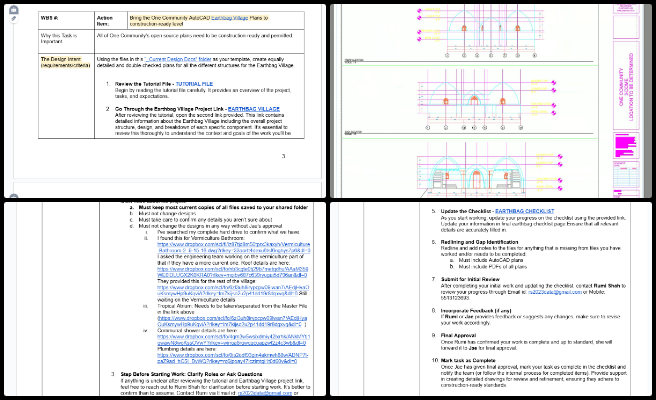
DUPLICABLE CITY CENTER PROGRESS
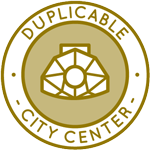 One Community is advancing sustainable future building through a Duplicable and Sustainable City Center that is LEED Platinum certified/Sustainable, can feed 200 people at a time, provide laundry for over 300 people, is beautiful, spacious, and saves resources, money, and space:
One Community is advancing sustainable future building through a Duplicable and Sustainable City Center that is LEED Platinum certified/Sustainable, can feed 200 people at a time, provide laundry for over 300 people, is beautiful, spacious, and saves resources, money, and space:
- Learn about this building and it’s function: Duplicable City Center Open Source Hub
This week, Andrew Chen (Industrial Designer) continued work on the Dormer second-floor window for the Duplicable City Center, contributing to the larger goal of sustainable future building. He incorporated new feedback from Jae and discussed material updates with Ariana. His research focused on identifying alternative wood material boards that are wide and strong enough without requiring gluing—supporting more efficient and eco-conscious construction methods central to sustainable future building. Andrew also explored kerf width to calculate the necessary gap between parts for cutting sheets and applied Jae’s feedback by updating material drawings with more accurate fractional units and reworking the instruction manual. Browse the visuals below.
Ariana V. Gutierrez Doria Medina (Industrial Designer) focused on redrawing parts to eliminate the use of glue and minimize the number of cuts efforts aligned with the principles of sustainable future building. To support this goal, some components were merged and complex shapes were intentionally avoided. Additional research was conducted on lumber and plywood options to enhance construction efficiency without compromising structural integrity or previously established measurements, further contributing to sustainable future building practices. Check out the photos below.
Ayushman Dutta (Mechanical Engineer) continued working on reviewing pipe materials for the Duplicable City Center hub connector design, and analyzed the hub connector to identify the lowest angles across all rows efforts that directly support the goals of sustainable future building. He examined the tolerance implications of changing the connector pipe diameter, testing various configurations including 8-inch and 10-inch pipe options. After careful evaluation, Ayushman and the design team determined that a 10-inch pipe would best meet the structural and performance requirements. He also explored different bolting options and identified the appropriate bolt and hole diameter specifications needed for the design. His analysis aimed to optimize performance while considering material availability and structural integrity key factors in advancing sustainable future building through efficient and scalable design practices. Browse the photos below to explore this work.
Lokesh Keshav Mali (Mechanical Engineer) continued focusing on developing the rain- and grey-water system layout for the Duplicable City Center, contributing to the broader mission of sustainable future building. He met with Mihir to clarify catchment zone details, then refined the SketchUp model by adjusting pipe routing, downspout tie-ins, and preliminary trench layouts. He also reviewed previous design references and researched grey-water pond sizing, trench infiltration methods, and first-flush diverter options—critical elements in creating water-efficient systems aligned with sustainable future building goals. The CAD updates reflect this research and are helping shape the final layout. Browse the photos below to explore this work.
Nupur Shah (Mechanical Engineer) continued reworking the Duplicable City Center hub connector Row 2 assembly with new team members and guided them through the ongoing tasks to help them get aligned with the project goals. She also worked on rebuilding the Row 2 components to address previous inconsistencies and ensure alignment with updated design requirements—an essential step in advancing sustainable future building. In addition to the CAD work, she organized and cleaned the main project spreadsheet to improve clarity and usability. A separate, dedicated sheet was created specifically for Row 2 to isolate its details, enabling easier tracking of part names, dimensions, and corresponding angles. These updates were implemented to streamline future revisions and reduce confusion when navigating the larger dataset. The revised spreadsheet layout now serves as a clearer reference for both design work and team collaboration, supporting the efficiency and accuracy needed for sustainable future building initiatives. Check out the photos below.
Sandesh Kumawat (Mechanical Engineer) continued working on the City Center Natural Pool and Eco-spa Designs. This week he developed a new folding mechanism in response to managerial feedback that the previous iteration could result in excessive losses. In support of sustainable future building, he implemented a simplified design where two plates are connected by a pair of rigid arms, and a timing belt drives one plate to slide over the other—reducing part count and streamlining assembly compared to earlier slot-based and four-bar configurations. Sandesh also proposed integrating a torsion spring at the hinge to automatically return the plates to their closed position once belt tension is released. Supporting CAD screenshots and motion study frames have been uploaded to the shared Dropbox folder to aid in ongoing sustainable future building design reviews. Browse the visuals below.
Srujan Pandya (Mechanical Engineer) continued helping with the Duplicable City Center FEA analysis. He reviewed Shu’s feedback and extracted key points to prepare for an upcoming discussion with Dipak regarding the potential need for re-analyzing the snow load data—an important consideration in sustainable future building. He updated and reformatted the Snow Loads section to align with review standards and edited for clarity and structure. While reviewing the Version 1 set, he identified missing gravity load data, began addressing the gaps where possible, and documented areas requiring further input. Additionally, Srujan finalized the Manufacturing Process section and confirmed that both the Snow Loads and Manufacturing Process content are ready for internal review, contributing to the accuracy and reliability essential for sustainable future building initiatives. The photos can be found below for your reference.
Vineela Reddy Pippera Badguna (Mechanical Engineer) continued working on conducted in-depth research on the Duplicable City Center greywater reuse systems as part of ongoing efforts to support sustainable future building. This week she examined common household sources such as washing machines, sinks, and showers, and reviewed products labeled as greywater-friendly. Her research included the use of greywater for plant irrigation, assessment of typical plant water requirements, and the integration of greywater-supportive features in new construction—all critical elements of sustainable future building. Vineela also studied percolation tests to evaluate soil infiltration, explored the role of constructed wetlands in filtering sediment and pollutants, and reviewed plumbing systems related to greywater, including sewer lines, ventilation pipes, grease interceptors, and septic tanks. To further her understanding of drainage layouts and applicable standards, she analyzed various greywater system designs through educational videos, covering Laundry-to-Landscape configurations, gravity-flow branched drains, pumped systems, commercial applications, and whole-house solutions. Additionally, she reviewed a DIY greywater system guide to understand the essential components of greywater collection, filtration, storage, and distribution. Have a look at the images below.
Yan “Jenni” Zu (Architectural Designer) adjusted the arrangement and variety of animals in the animal area to create a more natural and engaging environment aligned with the principles of sustainable future building. She repositioned the animals to improve their interaction with the landscape and enhance the realism of the scene. In addition, she optimized various details throughout the animal area, including the placement of plants, the texture of materials, and the alignment of small landscape elements. These refinements contributed to a more cohesive and visually appealing design. By focusing on both the animals and the surrounding elements, Jenni strengthened the overall atmosphere of the space and supported the broader goals of sustainable future building through thoughtful and immersive environmental design. See the photos below for more details.
HIGHEST GOOD FOOD PROGRESS
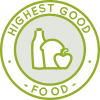 One Community is advancing sustainable future building through Highest Good food that is more diverse, more nutritious, locally grown and sustainable, and part of our open source botanical garden model to support and share bio-diversity:
One Community is advancing sustainable future building through Highest Good food that is more diverse, more nutritious, locally grown and sustainable, and part of our open source botanical garden model to support and share bio-diversity:
- Learn about the structures: Hoop House Hub | Aquapini & Walipini Open Source Hub
- See what we’ll be growing: Gardens & Hoop Houses | Large-scale Structures | Food Forest | TA
This week, the core team completed adding photos to the Master Tools, Equipment, and Materials/Supplies document. They continued reviewing and provided changes and comments on the Master Tools, Equipment, Materials/Supplies document. This included updating comments from “O” to “ORCH” and “SLAM” to “SA”, and specifically changing “AW” to AQ, WA to correct previous unapplied modifications. They also advised that the “F” and “FD” designations should be eliminated from the website, as the content of the former Food document has been fully incorporated into numerous sections and specific projects within the Master Tools, Equipment, Materials/Supplies document. The Highest Good Food initiative is a key component of One Community’s open source plans, focused on sustainable future building, and exemplifies the organization’s commitment through innovative design and implementation. Below are some of the images showcasing this work.
Chelsea Mariah Stellmach (Project Manager) continued her work on the Transition Food Self-sufficiency Plan menus and customization spreadsheets. She revised all of her reports based on feedback from Jae and Tyson. She contacted Shireen to discuss creating graphics for one of the reports and followed up with Tyson to better understand his feedback on her tutorials. Chelsea also rewrote the bulk goods section in one of the reports. As an essential aspect of One Community’s open source goals, the Highest Good Food initiative supports sustainable future building as a foundation for sustainable living. Below are some of the images showcasing this work.
Dirgh Patel (Volunteer Mechanical Engineer) continued assisting with the Climate Battery design evolutions. He worked on calculating heat gain from solar radiation by applying values for the summer angle, latitude, solar insolation, and roof angle. He completed the total heat gain estimation by dividing the roof into three sections and applying a transmissivity value of 0.80 for HDPE greenhouse glazing. He revised the boundary conditions explanation in the report to improve clarity, updated thermal simulation case descriptions, and provided a reference link for CAD file placement. Additionally, Dirgh edited boundary condition images to clearly indicate their significance and aligned thermal case results with related research. He simplified the pipe assembly explanation by removing rotational components and focused on showing how buried parts are connected and how the system can be disassembled and reassembled. One Community’s open source mission is powerfully reflected in the Highest Good Food initiative, which is focused on advancing sustainable future building for global benefit. The following visuals highlight key outcomes of this initiative.
Faeq Abu Alya (Architectural Engineer) continued his work on the Earthbag Village. He developed the Southwest and Southeast regions in Lumion, updated material settings, and added landscape elements to enhance the quality of visualizations. He updated the Southeast region by applying targeted material adjustments and integrating new terrain features and vegetation, improving scene realism. The work included modifying texture maps, tuning light interaction properties, and placing plant models and hardscape components. These updates standardized visual output and provided a clearer representation of design intentions for stakeholder review. One Community’s open source launch of sustainable future building begins with Earthbag Village, the first of seven planned villages providing housing. See below for some of the pictures related to this work.
Jay Nair (BIM Designer) continued working on Aquapini and Walipini Planting and Harvesting lighting and HVAC design. He continued working on the lighting energy calculations for Greenhouse Walipini 1. He focused on updating the inputs for each zone using updated fixture specifications and seasonal light availability data. The adjustments were made within the standardized project format to ensure accurate representation of energy requirements and support effective planning for lighting integration. The Highest Good Food initiative plays a leading role in One Community’s open source platform, promoting sustainable future building through sustainable and participatory development. Below are some of the images showcasing this work.
Keerthi Reddy Gavinolla (Software Developer) continued working on the Highest Good Food page, specifically details for the Soil Amendment page. She edited the document based on the current website content. She compared the document with the website, removed outdated sections, refined the formatting, and made improvements to enhance clarity and maintain consistency. She also went through the bugs document and tested some pull requests on the development site. And Keerthi updated the Moonfall, Expressers, and Lucky Star Team Blog #642. Built on One Community’s open source foundation, the Highest Good Food initiative is dedicated to sustainable future building, empowering communities through self-sustaining systems. Her contributions are showcased in the collage below.
Nitin Parate (Architect) started contributing to the Highest Good Food and reviewed the software environment and agreement documents, then examined the HGN system, video tutorials, setup instructions, and communication protocols. He studied underground greenhouse systems—Walipini, Aquapini, and Zenapini—that use the earth’s stable temperature of around 13°C to enable year-round cultivation. A Walipini is the basic model, Aquapini incorporates aquaponics, and Zenapini focuses on biodiversity and aesthetics. Nitin also researched the frost line in India, which is shallow or absent in most areas, and studied plant placement strategies such as positioning tall light-filtering trees on the south side and grouping cross-pollinating species. He focused on three Walipini types: Walipini 1, designed for arid frost-free zones, supports 26 desert species including the endangered yeheb nut and is zoned by light and maintenance needs. Walipini 2 accommodates 142 temperate and subtropical fruit trees, maintains a temperature range of 0–32°C, provides 400 chill hours, and employs espalier training, defoliation, and supplemental LED lighting. Walipini 3 uses a layered structure with overstory, mid-story, understory, and ground cover to maximize space, light, and heat efficiency. Zenapini 1 replicates a cool, humid cloud forest for rare and medicinal species, while Zenapini 2 mimics a tropical rainforest with a focus on biodiversity and education. Nitin created a comparative table summarizing key differences among these structures. He also reviewed renders and the master plan to better understand spatial layout and system integration. He proposed contributing to a section explaining the difference between ground level and structural depth, as well as systems like gravity-fed drainage to a central pond and passive cooling using underground piping. To support this, he suggested adding an infographic or animated graphic and offered to create a reference layout for the graphics team. He is currently working on an explanatory sectional elevation infographic of Zenapini 2, based on its structural and environmental similarities to Zenapini 1. The Highest Good Food initiative plays a leading role in One Community’s open source platform, promoting sustainable future building through sustainable and participatory development. Below are some of the images showcasing this work.
Pallavi Deshmukh (Software Engineer) continued working on adding the new Zenapini 2 content to the Aquapini and Walipini Planting and Harvesting page. She completed and submitted information for two interviews. She continued working on adding Zenapini #2 content from Silin to the website, completed the page, and submitted it for review. Pallavi also created new content for blog 642 and collaborated closely with her teammates, reviewing their suggestions and incorporating feedback to help produce a clear, consistent, and polished final version. In alignment with One Community’s open source objectives, the Highest Good Food project integrates sustainable future building into a larger vision of regenerative living. Her contributions are highlighted in the collage below.
Shivangi Varma (Volunteer Architectural Designer And Planner) continued contributing to the Highest Good Food and developed an understanding of its various components, including the design and masterplan as well as the overall intent and organizational structure of the initiative. Her tasks focused on suggesting image additions where needed, creating sublists, updating the contents page, highlighting key quotes, and improving legibility and accessibility to different sections of the page. She adjusted formatting and refined the page’s structure. Shivangi also watched Loom videos explaining how to add different types of media and began inserting placeholders for images, text, and hyperlinks as instructed. The Highest Good Food initiative plays a leading role in One Community’s open source platform, promoting sustainable future building through sustainable and participatory development. Below are some of the images showcasing this work.
Tyson Denherder (Volunteer Pioneer Team Member) continued contributing to the Highest Good Food by reviewing and providing comments on the Food Procurement and Storage Overview, the Updated Food Self-Sufficiency Plan Page Report, and the Recipe Build-Out Tool Page Report. He completed inputting recipes into the recipe build-out tool to test the instructions and assess its usability. He made several edits to improve the tool’s functionality and recorded and shared videos describing the changes. Tyson also contacted Chelsea to discuss the updates, and they are working on scheduling a virtual meeting to review ideas and align on next steps. The Highest Good Food initiative plays a leading role in One Community’s open source platform, promoting sustainable future building through sustainable and participatory development. Below are some of the images showcasing this work.
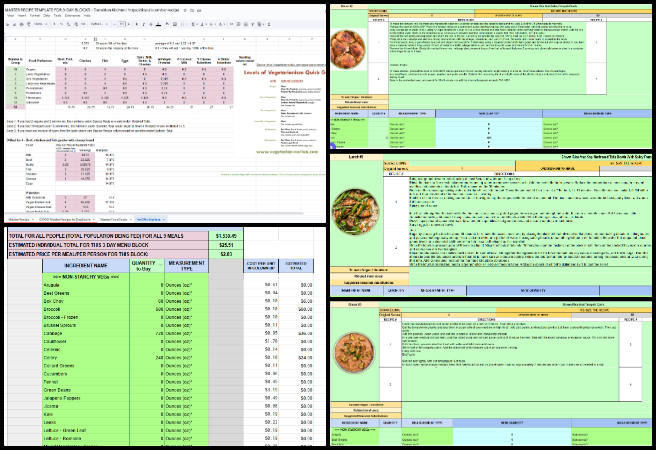
HIGHEST GOOD ENERGY PROGRESS
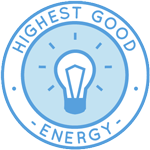 One Community is advancing sustainable future building through Highest Good energy that is more sustainable, resilient, supports self-sufficiency and includes solar, wind, hydro and more:
One Community is advancing sustainable future building through Highest Good energy that is more sustainable, resilient, supports self-sufficiency and includes solar, wind, hydro and more:
- Learn about the open source sustainable-energy foundations: Solar, Hydro, and Wind
- Explore our research into the most sustainable products and companies for saving water and energy: Insulation, Eco-laundry, Lightbulbs and Light Bulb Companies, Doors and Door Companies, Windows and Window Companies, Toilets, Faucets and Faucet Accessories, Urinals, and more.
This week, Dishita Jain (Data Analyst) continued supporting with the Highest Good Energy research and cost analysis for helping people create their own sustainable futures. Her tasks focused on the Energy Infrastructure Cost Analysis and Visualizations task under the HG Energy project. She replaced image links using the master Excel sheet, and consolidated multiple tabs from separate spreadsheets into a single master file. She organized all charts into one spreadsheet, applied color coding, and created a table of contents on the first page linking to individual tabs. Dishita also implemented feedback from Jae by adjusting line spacing and updating captions. Under OC Administration, she completed team reviews for the Blue Steel and Binary Brigade teams, added comments, and uploaded collage to WordPress for both the teams. One Community’s open source mission is powerfully reflected in the Highest Good Energy initiative, which advances sustainable future building as a model for global benefit. Below are some of the images showcasing this work.
Shravan Murlidharan (Volunteer Electrical Engineer) continued contributing to the Highest Good Energy component by assisting with off-grid and grid-tied solar microgrid. He worked on analyzing and improving off-grid versus on-grid profit calculations by identifying key limitations in the original example and proposing a revised, visually supported version. He also researched solar microgrids, locating relevant research papers to expand his technical understanding of their architecture and implementation. He summarized content from the Highest Good Energy section of the One Community platform and reviewed supporting articles to build a clearer picture of sustainable energy practices. This project furthers One Community’s goal of sustainable future building. A comparison of solar incentive programs, net metering policies, and financial benefits across various U.S. regions was developed, including a structured summary and recommendations based on residential and commercial viability. Further analysis was conducted on grid-tied remote energy infrastructure, focusing on solar panel setup, inverter configuration, utility interface, and cost modeling relevant to off-grid deployment. In parallel, he examined titanium-based solar technology developed in Japan, paying attention to its experimental performance characteristics and potential applications in renewable energy systems. Insights from both infrastructure design and materials innovation were connected to assess the future direction of clean energy solutions, especially for remote environments. The week concluded with a comparative review of energy load profiles across residential, commercial, and industrial sectors in the U.S., evaluating hourly, daily, and monthly demand trends, typical appliance contributions, and seasonal variations in energy usage. Load shape differences and peak demand behaviors were also assessed to understand sector-specific patterns and inform system planning considerations.Guided by its open source philosophy, One Community developed the Highest Good Energy initiative to pioneer sustainable solutions by sustainable future building. His contributions are shown in the collage below.
HIGHEST GOOD EDUCATION PROGRESS
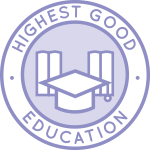 One Community is advancing sustainable future building through Highest Good education that is for all ages, applicable in any environment, adaptable to individual needs, far exceeds traditional education standards, and more fun for both the teachers and the students. This component of One Community is about 95% complete with only the Open Source School Licensing and Ultimate Classroom construction and assembly details remaining to be finished. We’ll report on the final two elements to be finished as we develop them. With over 8 years of work invested in the process, the sections below are all complete until we move onto the property and continue the development and open sourcing process with teachers and students – a development process that is built directly into the structure of the education program and everything else we’re creating too:
One Community is advancing sustainable future building through Highest Good education that is for all ages, applicable in any environment, adaptable to individual needs, far exceeds traditional education standards, and more fun for both the teachers and the students. This component of One Community is about 95% complete with only the Open Source School Licensing and Ultimate Classroom construction and assembly details remaining to be finished. We’ll report on the final two elements to be finished as we develop them. With over 8 years of work invested in the process, the sections below are all complete until we move onto the property and continue the development and open sourcing process with teachers and students – a development process that is built directly into the structure of the education program and everything else we’re creating too:
- Program Overview: Education Open Source Hub
- How the components work together in designing human orchestrated eco-abundance: How to use the Education for Life Program
- Lesson Plans for Life – Lesson Plans How-to
- Foundations of Outstanding Leaders, Teachers, and Communicators
- Curriculum for Life
- Teaching Strategies for Life
- Learning Tools and Toys for Life
- Evaluation and Evolution
This week, Harshitha Rayapati (Program Manager) continued work on detailing deliverables for the Highest Good Education software platform, outlining various components, developing Figma designs, and expanding the visual layout of the student dashboard. She focused on refining the Figma design for both the teacher and student dashboards. She incorporated prior feedback into the student dashboard’s activity dropdown page, ensuring clearer functionality and a cleaner interface. On the teacher’s side, she updated the grade submissions landing page to enhance usability and visual consistency. Harshitha also revised the assignment submission view across both dashboards to create a more unified user experience. Additionally, she improved the design and function of the generic form task builder within the teacher dashboard. She also compiled the weekly blog update, reviewed the housing team’s progress, edited the blog page, and created a collage. The One Community model of sustainable future building, exemplified by sustainably built classrooms like this, represents sustainable change for the whole planet. See the collage below for her work.
HIGHEST GOOD SOCIETY PROGRESS
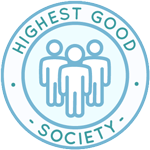 One Community is advancing sustainable future building through a Highest Good society approach to living that is founded on fulfilled living, the study of meeting human needs, Community, and making a difference in the world:
One Community is advancing sustainable future building through a Highest Good society approach to living that is founded on fulfilled living, the study of meeting human needs, Community, and making a difference in the world:
- Read the Highest Good society overview: Highest Good Society
- Learn about the model for fulfilled living and sharing: A Day in the Life
- Learn about the 4 economic models: RBE | For-profit | Non-profit | Entrepreneurship
- Learn about our open source community collaboration and management software: The Highest Good Network
This week, the core team completed over 32 hours managing One Community’s volunteer-work review (not included in the summaries here), emails, social media accounts, web development, new bug identification, and bug-fix integration for the Highest Good Network software, as well as interviewing and onboarding new volunteer team members. They shot and incorporated the video above which explains how sustainable future building is a foundation of the bigger picture of everything One Community is doing. The image below shows some of this work.
Govind Sajithkumar (Project Manager) continued focusing on analytics and content management for Facebook and Instagram on Meta platforms. He managed content for Meta’s social channels by refreshing the Facebook and Instagram feeds with new posts and setting up a regular posting schedule. He entered content details and metadata into the Open Source spreadsheet for tracking and analysis. Govind also finished the weekly update of social media analytics, which included collecting and processing new audience data for both platforms. Additionally, he performed PR Review Team Management by providing feedback on team members’ documents, modifying a WordPress site with the team’s weekly summary and collage, and updating the PR Review Team Table and HGN PR spreadsheet. He also reviewed fellow admins and submitted his admin feedback table. This effort supports One Community’s broader mission of sustainable future building. The images below showcase some of this work.
Jaiwanth Reddy Adavalli (Project Manager) continued developing the Job Applicants page along with components of the Highest Good Network Phase 2 and Phase 4 dashboards, including the PR Team analytics section. He tested several pull requests in the Highest Good Network software and continued work on the development of the PR Review Team Analytics software and dashboard. He updated the action items for the corresponding Figma wireframes. Jaiwanth also monitored software team management documents to manage task creation and followed up on the progress of those tasks. As part of the PR review team, he reviewed the pull requests of the volunteer team assigned to him. This project plays an important role in One Community’s commitment to sustainable future building. The following images show his work for the week.
ADMINISTRATION TEAM
The Administration Team summary, covering their work administrating and managing most of One Community’s ongoing process for sustainable future building was managed by Bhakti Tigdi (Project Manager) and includes Anuneet Kaur (Administrator), Harsha Ramanathan (Administrator), Himanshu Mandloi (Engineering Project Manager), Khushie Zaveri (Communication Strategist), Neeharika Kamireddy (Data Analyst), Olawunmi “Ola” Ijisesan (Administrative and Management Support), Olimpia Borgohain (Data Analyst and Team Administrator), Rachna Malav (Data Analyst), Rishi Sundara (Quality Control Engineer and Team Administrator), and Vedansh Rathi (Administrator). The Highest Good Network software is how we’ll be managing and objectively measuring our process for sustainable future building through our social architecture, construction, production, and maintenance processes.
This week, the Administration team supported a variety of content, coordination, and technical tasks that spanned sustainability research, blog development, SEO optimization, and software testing. Anuneet focused on identifying sustainable materials across multiple categories, managed volunteer bios, and began drafting the Licensing and Accreditation page for the Highest Good Education Program. She also contributed to interface design using Figma and completed several admin-related reviews and content updates. Harsha conducted in-depth research on sustainable door materials, particularly fiberglass, and compiled supporting data and scholarly references to guide graphic content creation. Himanshu managed the timelog process, followed up on member submissions, created new content features for the Job Application Listing Page, authored a blog post on sustainable living, and reviewed admin contributions for quality and accuracy. This progress reinforces One Community’s strategy for sustainable future building.
Khushie launched social media efforts for the metric system campaign, managed scheduled content across platforms, responded to new team questions, and completed blog formatting and publication tasks. Neeharika coordinated with the software team by assigning tasks, reviewing PR dashboards, and following up with developers, while also completing interviews and weekly admin duties. Ola reviewed pull request documentation for consistency, prepared workspace materials for the team, and organized weekly report folders. Olimpia analyzed LinkedIn analytics, created visual KPI reports, and contributed to blog and admin duties while progressing on new post creation. Rachna worked on her pending SEO pages and internal follow-ups, though interviews couldn’t proceed due to a lack of candidate outreach. Rishi finalized team collages, consolidated and optimized blog posts, and reviewed and tested multiple pull requests. Vedansh completed his training, organized over 500 AI-generated songs, and ensured quality control across all output in alignment with project guidelines. This work contributes to One Community’s commitment to sustainable future building. See below to view images of their work.
GRAPHIC DESIGN TEAM
The Graphic Design Team’s summary includes Aurora Juang (Graphic Designer), Yulin Li (Graphic Designer), Qinyi Liu (Graphic Designer), and Rutal Deshmukh (Graphic Designer), covering their work on graphic designs for sustainable future building.
This week, Aurora refined new volunteer bio announcements and updated outdated resources using past tutorial references to ensure formatting and accuracy. Through clear communication with Jae and Sara, she supported onboarding improvements aligned with sustainable future building. Qinyi Liu designed and refined game-style characters and social media visuals using MidJourney, ChatGPT, and Photoshop, adding gesture variations and bio images. Rutal updated social media graphics, completed announcement bios, and coordinated next steps with the team to support sustainable future building. Yulin revised infographics and created visuals to improve clarity and consistency. See the Highest Good Society pages for more on how this contributes to sustainable future building. See the collage below to view some of their work.
HIGHEST GOOD NETWORK PROGRESS
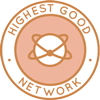 One Community is advancing sustainable future building through open source Highest Good Network® software that is a web-based application for collaboration, time tracking, and objective data collection. The purpose of the Highest Good Network is to provide software for internal operations and external cooperation. It is being designed for global use in support of the different countries and communities replicating the One Community sustainable village models and related components.
One Community is advancing sustainable future building through open source Highest Good Network® software that is a web-based application for collaboration, time tracking, and objective data collection. The purpose of the Highest Good Network is to provide software for internal operations and external cooperation. It is being designed for global use in support of the different countries and communities replicating the One Community sustainable village models and related components.
- Learn about our open source community collaboration and management software: The Highest Good Network
This week, the core team continued their work on the Highest Good Network pull requests and confirmed the following fixes: Create New User form issues (#3169), formatting issue in the Select Featured window badges list (#3342), display of suggestion categories showing “nan” (#3443), role icons and header/table adjustments (#3276), date autofill (#3162), bounding box limitation of the management checkbox info to the actual image (#3088), hotfixes on the User Profile Page (#3462), profile page loading optimization (#3445), checkbox notification functionality on the Reports page (#3195), button functionality for ‘Edit Job Application Email CC’ (#3455), ability to edit and limit link type (#3337), interaction with the deadline check-in box (#2926), name overflow on the dashboard (#2864), team weekly summaries in dark mode (#3429), and functions added to the material list in the BM dashboard (#3362). This output reflects One Community’s work in sustainable future building.
The following issues were not fixed: member column filter (#3220 and #1257) and implementation of the Skills section on the hgnhelp/profile page (#3400). Additional tasks included assigning work to six volunteers. They were unable to test PR #2417 and #1020 (Force new password for new users) due to a bug preventing the creation of a new team, and also unable to test PR #3254 (update equipment tool) because Phase 2 data is not available on the main branch. See the Highest Good Society and Highest Good Network pages for more on how this aligns with One Community’s commitment to sustainable future building. The collage below shows some of this work.
ALPHA SOFTWARE DEVELOPMENT TEAM
The Alpha Software Team, covering their progress on the Highest Good Network software, was managed by Lin Khant Htel (Frontend Software Developer) and includes Nikita Kolla (Full Stack Developer). This software is an internal management and communication platform with the goal of sustainable future building.
This week, Lin reviewed and approved PR #1470 after testing the code locally and confirming all test cases passed. She also verified weekly summaries, photos, and videos from the Alpha Team, supported team coordination, and contributed to sustainable future building. Nikita resolved environment setup issues and the necessary functions for cron job testing, then wrote additional test cases. See the Highest Good Society and Highest Good Network pages to learn more on how this relates to sustainable future building. See some of the team’s work in the collage below.
BINARY BRIGADE SOFTWARE DEVELOPMENT TEAM
The Binary Brigade Team’s summary, overseeing advancements in the Highest Good Network, was managed by Dishita Jain (Data Analyst) and includes Ramsundar Konety Govindarajan (Software Engineer). The Highest Good Network software is how we’ll be managing and objectively measuring our progress in sustainable future building through our social architecture, construction, production, and maintenance processes.
This week, Ramsundar worked on task 1004, which involved a bug where, if a user (User A) was viewing another team member’s timelog (User B) and logged time using the timer, the frontend temporarily displayed User A’s new time entry within User B’s view. While the backend correctly attributed the logged time to User A, the UI created a momentary inconsistency. He initially suspected the issue was related to Redux architecture but later identified that the problem was due to the Redux timeEntries slice being updated immediately after a time entry was created, without considering whose page was being viewed. This caused the updated data for User A to appear on User B’s page. The fix involved adding a check before updating Redux to determine whether the page being viewed belongs to the person who just logged time. If the user is viewing someone else’s page, the UI state is left unchanged. If the user is viewing their own page, the state is updated as expected. A page refresh always loads the correct data from the server. He implemented the fix and created a new pull request (#3742). See the Highest Good Society and Highest Good Network pages to learn more about how this work relates to sustainable future building. View some of the team’s work in the collage below.
BLUE STEEL SOFTWARE DEVELOPMENT TEAM.
The Blue Steel Team’s summary, presenting their work on the Highest Good Network software, was managed by Dishita Jain (Data Analyst) and includes Humemah Khalid (Software Engineer/Backend Developer), Linh Huynh (Software Engineer), and Ramakrishna Aruva (Software Engineer). The Highest Good Network software is how we’ll be managing and objectively measuring our process for sustainable future building.
This week, Humemah worked on enabling functionality for users with appropriate permissions to reset or change the passwords of other users. This required modifying the system to allow admins or owners to assign the “Update Password (Others)” permission through the Permissions Management section. The work relates to previous pull requests #2860 and #1146 and remains in progress. Linh focused on writing and refining unit tests for several backend controller files, including popupEditorController.js, bmMaterialsController.js, emailController.js, and inventoryController.js. For inventoryController.js, Linh expanded and updated eight test cases to improve coverage, targeting scenarios such as inventory retrieval by project and WBS ID, handling permission checks using hasPermission, and simulating different database outcomes using mocked Mongoose models like Item, ItemType, and projects. These tests addressed both success and error responses, including 403 and 500 status codes, as well as cases involving missing inputs or dependent data. In popupEditorController.js, Linh added tests focused on editor configuration and error handling for invalid inputs. Updates to bmMaterialsController.js and emailController.js included test cases for retrieving material entries and validating email content. All tests were implemented using Jest with mock modules to ensure isolation, and changes were committed to the linh_unitTest_inventoryController branch under PR #1530. A total of five hours was logged for test development and integration. Ramakrishna resumed work on an issue from the previous week by syncing with the latest development changes and reviewing project updates. He examined the structure of report-related methods and APIs, and analyzed the implementation of lost hours tracking, focusing on how these methods integrate with projects and individual members to understand the current data flow and system behavior. See the Highest Good Society and Highest Good Network pages to learn more about how their work contributes to sustainable future building. See below to view images of their work.
CODE CRAFTERS SOFTWARE DEVELOPMENT TEAM
The Code Crafters Team, covering their work on the Highest Good Network software, was managed by Sai Moola (Software Engineer) and includes Ashrita Cherlapally (Software Engineer), Greeshma Palanki (Software Engineer), Humera Naaz (MERN developer), Pratyush Prasanna Sahu (Software Engineer), Ravikumar Sripathi (Software Engineer), and Sundar Machani (Software Engineer). The Highest Good Network software is how we’ll manage and objectively measure our process for establishing abundant community systems through our social architecture, construction, production, and maintenance processes, and support widespread and lasting eco-lifestyle access. This aligns with One Community’s broader goal of sustainable future building.
This week, Ashrita worked on implementing key features for the interactive map application. She developed API endpoints to aggregate applicant data by country and time range using MongoDB and Express, enabling role-based and date-based filtering. She also created a data seeding script to populate the database with realistic sample entries, which allowed for functional testing of weekly, monthly, yearly, and custom date filters. Greeshma cleaned and refactored code related to hierarchy access, raised a pull request for verification, and confirmed the feature was working as expected. She reviewed a new task, requested assignment of the corresponding timelog, and made changes to update a person’s end date based on the last week they logged hours instead of their deactivation date, ensuring the change was reflected across the application. Greeshma also spent time learning more about Azure and Redux state management to better support current and future tasks. This activity contributes to One Community’s sustainable future building objectives. Ravi focused on refining components of the education platform’s analytics and progress-tracking features. An actionable analytics dashboard was designed to help students identify performance trends, strengths, and gaps across subjects, featuring an interactive line graph with a subject selection filter. A visual layout was developed to display mastery levels across subjects by categorizing education atoms into completed, in-progress, or not completed states, with the ability to explore suggested atoms and save them based on performance or prerequisites. A dynamic interface was also built for the Education Molecules section, allowing atoms to visually change states — gold for completed, greyed-out for not completed, and colored for in-progress — with clickable atoms opening a floating details view that includes an option to save the atom to the “My Saved Interests” section. All of this work contributes to advancing sustainable future building by supporting personalized learning paths and better educational outcomes. The enhanced analytics and visual interfaces are aligned with sustainable future building by empowering learners with actionable insights. This effort to improve platform interactivity is another step toward sustainable future building through accessible and meaningful data visualization. The continued focus on performance tracking tools reflects a commitment to sustainable future building that supports long-term user engagement and growth. See the Highest Good Society and Highest Good Network pages for more on how this relates to sustainable future building. View some of the team’s work in the collage below.
DEV DYNASTY SOFTWARE DEVELOPMENT TEAM
The Dev Dynasty Team’s summary, covering their work on the Highest Good Network software, was managed by Zhifan Jia (Software Engineer) and includes Dharmik Patel (Software Engineer), Manvitha Yeeli (Software Engineer), Mohan Satya Ram Sara (Software Engineer), Prasanth Bhimana (Software Engineer), Saicharan Reddy Kotha (Software Engineer) Shraddha Shahari (Software Engineer), Vamsi Krishna Rolla (Software Engineer), and Varsha Karanam (Software Engineer). The Highest Good Network software is how we’ll manage and objectively measure our process for establishing abundant community systems through our social architecture, construction, production, and maintenance processes to support widespread and lasting eco-lifestyle access. This supports One Community’s aim of creating sustainable future building models.
This week, Dharmik completed the team code filter set feature by resolving linting issues, submitting final pull requests for frontend and backend, and recording a demo video. He began exploring requirements for the Team Analytics Dashboard, reviewed related documentation and older pull requests, and created a new branch to begin routing development. Manvitha modified backend responses to support pull request review data aggregation from both HighestGoodNetworkApp and HGNRest using the GitHub API, added filters and pagination, and investigated further optimizations due to slow data retrieval. She also addressed a comment from PR3670. Mohan worked on two key areas of the HGN Software Development project. First, he resolved a crash issue during manual date editing on the task page by refactoring the input component and wrapping logic in a try-catch block, ensuring the application remained stable. Second, he implemented dark mode and login functionality for the HGNForm page by integrating the ThemeProvider, applying Tailwind classes, and testing interface behavior. These updates supported usability enhancements tied to sustainable future building by strengthening infrastructure reliability. Prasanth reviewed and tested PRs 3727, 3684, 3603, 3582, 1337, 3548, and 1375, covering promotion confirmations, job posting logic, listing filters, analytics, and API functionality for member data. He also collaborated on the Phase-2 document review with a focus on sustainable future building, verifying features and preparing a structured action item list.
Saicharan reviewed PRs 3548, 1375, 3603, 3620, 3629, and 3727, validating promotion confirmation boxes, team member creation, job filters, dashboard expense graphs, and job posting workflows. He joined the Development Team and was assigned to audit Phase-2 documentation with teammates, focusing on ensuring the codebase advances sustainable future building objectives. Shraddha reviewed the AddConsumable PR tests and resolved lint errors causing pipeline failures. She continued work on PR2891 by resolving conflicts, updating UI code, and identifying dark mode issues, and began addressing conflicts in PR3612. Vamsi fixed missing data fields in the database affecting the stacked horizontal bar chart and addressed integration issues between frontend and backend APIs. He introduced interactive tooltips for review category breakdowns, adjusted styling for clarity, and refactored the codebase by modularizing components, isolating logic, and creating a service layer. His work improved dashboard usability as part of broader goals tied to sustainable future building. Varsha reviewed the HGN tasks document, identified unassigned items, and submitted a pull request for her assigned task. She fetched and formatted FAQ data for the Job Application Listing Page, embedded a video in an answer, and began testing the Phase-2 implementation. She also started work on the teams search endpoint, contributing toward sustainable future building through clearer information access. Zhifan continued work on task edit logs by debugging duplicate success messages and resolving a backend issue that logged resource changes unnecessarily. He updated dashboard task count logic, created a pull request with testing and video demos, and fixed merge conflicts and prior test failures. He also addressed a bug causing incorrect popup messages during task edits and updated the submitTasks function accordingly, with backend progress depending on additional merged fixes. See the Highest Good Society and Highest Good Network pages for more on how this relates to sustainable future building. View some of the team’s work in the collage below.
EXPRESSERS SOFTWARE DEVELOPMENT TEAM
The Expressers Team’s summary, which covers their work on the Highest Good Network, was managed by Casstiel Pi (Software Engineer) and includes Meenashi Jeyanthinatha (Full Stack Developer), Rahul Trivedi (Software Engineer), and Reina Takahara (Software Developer). The Highest Good Network software helps us manage and objectively measure our progress toward sustainable future building through innovative software development, testing, and collaboration. This week, Casstiel continued handling managerial responsibilities for end-of-week summaries and the team’s weekly review in the absence of manager Strallia Chao. After determining that the previously claimed feature could not be completed due to the termination of the MySpace API service, he identified and claimed a new feature involving the creation of an appropriate auto-poster for Plurk. He also reviewed the end-of-week summaries and weekly work submissions for all team members. Rahul focused on enhancing the performance and visual consistency of the graph components by implementing a loading screen to indicate data fetching and updating progress. He refined the horizontal graph with updated colors and styling to match Figma design specifications and adjusted the layout for better alignment with the intended design, including optimizing the PR bar graph for smaller screens, improving animations, and adjusting component alignment for improved responsiveness. This aligns with One Community’s pathway to sustainable future building.
Reina addressed feedback on pull request 3458 by reinstating dark mode compatibility for the cost breakdown line graph chart and adjusting styling based on reviewer comments. She also began work on dark mode support and permission handling for the skill addition feature on the hgn/skills page. Meenashi updated the userSkillsProfile page to fetch data based on a specified userId rather than defaulting to the logged-in user and incorporated role-based permissions into the AdditionalInfo component to limit editing access. She fixed alignment issues in the Question mern-work section, replaced alerts with toast.error for better user feedback, added required field validations, and implemented sorting to ensure questions appear in a consistent order. She identified that the updateUserSkillsProfileFollowUp function needs to be updated to accommodate the Administrator role and discovered that volunteers lack the necessary getUserProfiles permission in the frontPermissions array, which is needed to display basic user information. Additionally, she modified the backend API to accept a userId as a query parameter and return matching records, though the frontend continues to show a loading state which is still under investigation. See the Highest Good Society and Highest Good Network pages for more on how this contributed to sustainable future building. See the collage below to view the team’s work.
LUCKY STAR SOFTWARE DEVELOPMENT TEAM
The Lucky Star Team’s summary, which covers their work on the Highest Good Network, was managed by Barnaboss Puli (Volunteer Software Engineer) and includes contributions from Dipti Yadav (Software Engineer), Ganesh Karnati (Software Engineer), Kedarnath Ravi Shankar Gubbi (Software Engineer), Manoj Gembali (Software Engineer), Pranav Govindaswamy (Software Developer), Veda Bellam (Software Engineer), and Venkataramanan Venkateswaran (Software Engineer). Their work continued to support our goal of sustainable future building through collaborative and cross-functional software development. This week, Barnaboss worked on the deadline tracking system for the Elite Bug-fix Team and also developed backend APIs for the Phase 2 Summary Dashboard’s Utilization Rate and Downtime of Tools/Equipment bar graph and for the Twitter/X auto-poster feature. Dipti worked on two tasks, focusing on aligning a column in the WBS tasks table to the left and fixing the layout of a red circular icon. She reviewed the task details, identified relevant files, used debugging tools and console logs to understand the code, and began applying the necessary changes. Ganesh worked on the frontend of the Weekly PR Grading screen for the PR Review Team Analytics Dashboard by implementing an editable table, input validation for PR numbers, grade selection inputs, real-time synchronization, and visual improvements, while preparing for backend integration. Kedarnath analyzed the Job Application Listing Page to determine layout and placement for a new What We Do section, ensuring icons link to the correct pages and that descriptions are presented clearly. Manoj integrated the backend of the Cost Prediction Chart with its frontend component, ensured compatibility with light and dark modes, resolved merge conflicts, fixed UI issues, and updated chart labels in response to earlier feedback.
Pranav worked on displaying a suggested job list based on user responses by integrating the One Community logo, creating a category dropdown, building a navbar with search and filtering functionality, and implementing pagination for job ads. He ensured that data was fetched correctly from the backend and dark mode compatibility was addressed. All changes were submitted in pull request 3741. Veda implemented a new frontend component named ApplicantSourceDonutChart to display applicant source data using a donut chart. The chart supports percentage and value labels along with filters for date range, role selection, and comparison type. On the backend, she added a controller method for the analytics route using MongoDB aggregation. The component is currently placed on a test page while the final UI location is determined, and additional integration and enhancements are still in progress. Venkataramanan raised three pull requests—3734, 3735, and 3736—focused on UI and UX improvements including alignment fixes and label formatting. He monitored Slack for blockers, resolved issues, and reviewed internal bug documentation to understand system architecture and debugging patterns. He also explored Redux usage and reviewed reducers to better understand global state management. See the Highest Good Society and Highest Good Network pages for more on how this relates to sustainable future building. See the collage below to view the team’s work.
MOONFALL SOFTWARE DEVELOPMENT TEAM
The Moonfall Team’s summary, which covers their work on the Highest Good Network, includes Alisha Walunj (Software Engineer) and Bhavpreet Singh (Software Engineer). The Highest Good Network software is how we’ll manage and objectively measure our progress toward sustainable future building through innovative software development, testing, and collaboration. This week, Alisha began working on the Job Posting Page Analytics task, which involved creating a pie chart to display the breakdown of applicants by reason for volunteering. She started by reviewing the requirements and configuring the API on the backend. The database schema was updated according to the specified fields. While setting up the API route, she encountered uncertainty about whether to integrate it into the main routing file or place it within an existing analytics structure, ultimately deciding to configure a new route. Once the backend was set up, she moved on to the frontend, where she implemented the pie chart using the react-chartjs library, configured the chart labels and colors, and began styling the component. The frontend development is still in progress. Bhavpreet worked on frontend changes for three different features, focusing on adjustments related to data input handling and the display of charts when users select all or multiple teams. These changes included implementing logic to support multiple chart views depending on team selection. In addition to the frontend updates, Bhavpreet also created the basic backend structure to support these three features. See the Highest Good Society and Highest Good Network pages for more details on how this work supports sustainable future building. See the collage below to view the team’s work.
REACTONAUTS SOFTWARE DEVELOPMENT TEAM
The Reactonauts Team’s summary, covering their work on the Highest Good Network was managed by Olimpia Borgohain (Data Analyst and Team Admin) and Akshay Jayaram (Software Engineer). The team includes Fatima Villena (Software Engineer), Guirong Wu (Software Engineer), Haocheng Xu (Software Engineer), Kristin Dingchuan Hu (Software Engineer), Peterson Rodrigues dos Santos (Full Stack Developer), Rishwa Patel (Software Developer), and Siva Putti (Software Engineer). The Highest Good Network software helps manage and objectively continue to support by focusing on sustainable future building, social architecture, construction, production, and maintenance processes to build sustainable and thriving ecosystems. This solution is portable, scalable, and ideal for off-grid or sustainable living communities.
This week, Akshay worked on sustainable future building and focused on making the PeopleReport component more responsive and visually consistent, improved layout logic for pie charts, and provided steady coordination for the Reactonauts team through tracking and reporting. Fatima continued frontend work on the PR Dashboard, focused on the promotion eligibility table layout, implemented CSS styling, fixed alignment issues, and adjusted backend API routing to ensure proper data flow. Guirong worked on testing the automation task and collaborated with Rahul to prepare for deployment. She implemented UI fixes for dashboard components on small screens and addressed the blue square chart issue by identifying that the backend was returning zeros.
Haocheng encountered repository permission issues that resulted in a 403 error, reviewed and studied the codebase to understand the project. Kristin resolved a bug where tasks were not displaying under the “Projects” section of user profiles and contributed to backend development for the Promotion Eligibility table by adding a controller, route, and tested the GET endpoint using Thunder Client. Peterson updated the Teams page by adding a message and a button when a user searches for a non-existent team, that allowed for new team creation. Rishwa worked on the backend task for the PR Review Team Analytics Dashboard, focused on the Promotion Eligibility interactive table by implementing GET and POST API endpoints to fetch and update reviewer data. She also included backend logic to calculate required PRs. Siva restored the missing visual representation of assigned versus completed tasks in the “Task Completed” section of the Total Organization Summary dashboard, and ensured task completion metrics display correctly. See below for the work done on sustainable future building.
SKYE SOFTWARE DEVELOPMENT TEAM
Skye Team’s summary, covering their work on the Highest Good Network was managed by Olimpia Borgohain (Data Analyst and Team Admin) and Anthony Weathers (Software Engineer). The team includes Julia Ha (Software Engineer), Marcus Yi (Software Engineer), and Prit Patel (Software Engineer). The Highest Good Network software helps manage and objectively continue to support by focusing on sustainable future building, social architecture, construction, production, and maintenance processes to build sustainable and thriving ecosystems. This solution is portable, scalable, and ideal for off-grid or sustainable living communities.
This week, Anthony worked on sustainable future building and merged frontend and backend pull requests with the development branch. He confirmed that warning tracker icons displayed consistent names and ensured the Both warning button appeared correctly on the Blue Square details modal. He also set up a Google API and tested the email functionality related to the warning modal. Julia resolved a conflict between pull request 3646 and the development branch, allowing it to be merged. She also worked on the special filter feature on the Weekly Summaries Report page, added a dropdown to the Save Filter button so users could create or update filters. She also implemented a modal for users to enter filter names, add descriptions, and review their selections before saving.
Marcus was promoted to the development team. He addressed a Dependabot issue by applying backend dependency updates and made necessary repository adjustments. The frontend Dependabot remained paused and under review. Prit focused on removing unnecessary backend logic, reimplemented frontend logic for assigning default permissions to specific roles, and ensured access was granted to active Software Development Team members who had completed the required survey. See below for the work done on sustainable future building.
SOFTWARE PR REVIEW TEAM A-F
This week, the PR Review Team’s summary for team members with names starting from A–F, covering their work on the Highest Good Network software, was managed by Neeharika Kamireddy (Data Analyst). The Highest Good Network software is a foundation of what we’ll be using to measure our results of advancing sustainable future building. This week’s active members of this team were: Aayush Jayant Shetty (Software Engineer), Abdelmounaim Lallouache (Software Developer), Adithya Cherukuri (Volunteer Software Engineer), Ajay Naidu (Software Engineer), Akshay Gadsing (Software Engineer), Bangaru Babu Kota (Software Engineer), Carl Bebli (Software Developer), Carlos Martinez (Full-Stack Software Developer), Chinmay Joshi (Software Developer), and Deekshith Kumar Singirikonda (Developer). They contributed to advancing sustainable future building by thoroughly reviewing all the Highest Good Network pull requests shared in this week’s update. Learn more about how the Highest Good Network measures progress toward sustainable future building by exploring the Highest Good Network open-source hub. The collage below showcases a compilation of this team’s work.
SOFTWARE PR REVIEW TEAM G-N
This week, the PR Review Team’s summary for team members with names starting from G–N, covering their work on the Highest Good Network software, was managed by Govind Sajithkumar (Software Project Manager). The Highest Good Network software is a foundation for measuring our results of advancing sustainable future building. This week’s active members of this team were: Jaydeep Mulani (Software Developer), Juhitha Reddy Penumalli (Software Engineer), Kurtis Ivey (Full Stack Developer), Nahiyan Ahmed (Full Stack Software Developer), Nathan Hoffman (Software Engineer), and Neeraj Kondaveeti (Software Engineer). They contributed by reviewing all the Highest Good Network pull requests shared in this week’s update. Learn more about how the Highest Good Network measures progress toward sustainable future building by exploring the Highest Good Network open-source hub. The collage below showcases a compilation of this team’s work.
SOFTWARE PR REVIEW TEAM O-Z
This week, the PR Review Team’s summary for team members with names starting from O–Z, covering their work on the Highest Good Network software, was managed by Jaiwanth Reddy Adavalli (Software Project Manager). The Highest Good Network software is a foundation for measuring our results of advancing sustainable future building. This week’s active members of this team were: Rohith Mallipudi (Software Engineer), Sai Krishna (Software Engineer), Shashank Madan (Software Engineer), Uha Kruthi (Software Engineer), Vamsidhar Panithi (Software Engineer), and Yiyun Tan (Software Engineer). They contributed by reviewing all the Highest Good Network pull requests shared in this week’s update. Learn more about how the Highest Good Network measures progress toward sustainable future building by exploring the Highest Good Network open-source hub. The collage below showcases a compilation of this team’s work.
AND WE PRODUCED THIS WEEKLY UPDATES BLOG – CLICK HERE TO SUBSCRIBE
FOLLOW ONE COMMUNITY’S PROGRESS (click icons for our pages)
INVESTOR PAGES
GET INVOLVED
DONATE | WAYS ANYONE CAN HELP | MEMBERSHIP
CLICK HERE FOR ALL PAST UPDATES
 One Community
One Community